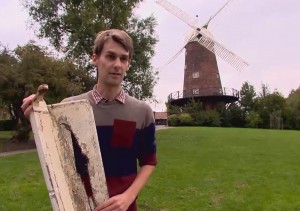
Described as Nottingham’s best kept secret, Green’s Windmill in Sneinton is one of three remaining flour mills located in a city in England.
The mill is steeped in history having been built in the early 1800s by the father of world-renowned mathematician and physicist George Green.
Situated in a quaint, yet quiet, area of Sneinton, the windmill is regarded as a hidden gem in the county.
Denis Staniforth is a long-time volunteer and still finds that the landmark surprises many locals.
He said:
It’s just one of the places you don’t know is there and you still get locals who can’t believe how beautiful it is.
The building, which became repurposed as a French polish factory, remained derelict for many years after it was wrecked in a blaze in 1947 when the polish set alight.
However, after a maths professor from Nottingham University raised the importance of George Green’s trailblazing work at a conference in Budapest, the wheels were set in motion for a remarkable restoration.
Under the George Green Memorial Fund, work to the mill was completed in the 1980s.
Along with a new science centre, the site is a fitting commemoration to the great intellectual – whose important math theorems are said to have inspired Albert Einstein and are still used to this day.
On top of being a fantastic site of heritage, the mill still produces flour on a daily basis.

John Bellingham works as a miller at Green’s and carries out the intensive process of washing, separating and grinding the flour, before packaging it for sale.
Despite the rigorous work, John insists he would have it no other way.
“I’ve always been quite an advocate of keeping traditional ways of working alive,” he said.
Although the mill was completely powered by wind in its heyday, there is now more of a reliance on electrical equipment due to its efficiency.
John added: “We brought in a machine from Austria which can grind 25 kilos of flour in 20 minutes.
“It could take the mill up to two hours on a bad day.”
What sets apart the windmill from sites of a similar ilk is the fact it is a volunteer-led institution.

Workshops teaching children how to bake as they learn about the history of the site are often put on – instilling a unique sense of community for residents.
Kieran Standring voluntarily runs many of the workshops and believes they can be very positive for the locals.
He said: “As a working windmill we produce baking ingredients and it makes complete sense to put them out for people to use – it’s great for the kids as well.”

It’s not all positive news for the mill, however.
Further funding is now required to replace two of the structure’s sails which are beyond repair.
Heritage officer at Green’s, Jamie Duff, hopes for the mill to be in full working order as soon as possible so that it can move forward as a business.
He said: “After the restoration we realised we’d need to run it like a business to survive, so we’re upping flour orders and doing more corporate work.
It’s all about running the mill from a commercial point of view, but also not losing the values of organic produce and the heritage of the site.
Ever since Mr Green purchased a plot of Sneinton land over 200 years ago, a rich history has been engrained in the area.
And for those currently involved at Green’s Windmill, all hearts are set on continuing a fantastic heritage.
This feature is based on episode 10 of A Day in the Life, broadcast on Notts TV. Click here to watch it.



















